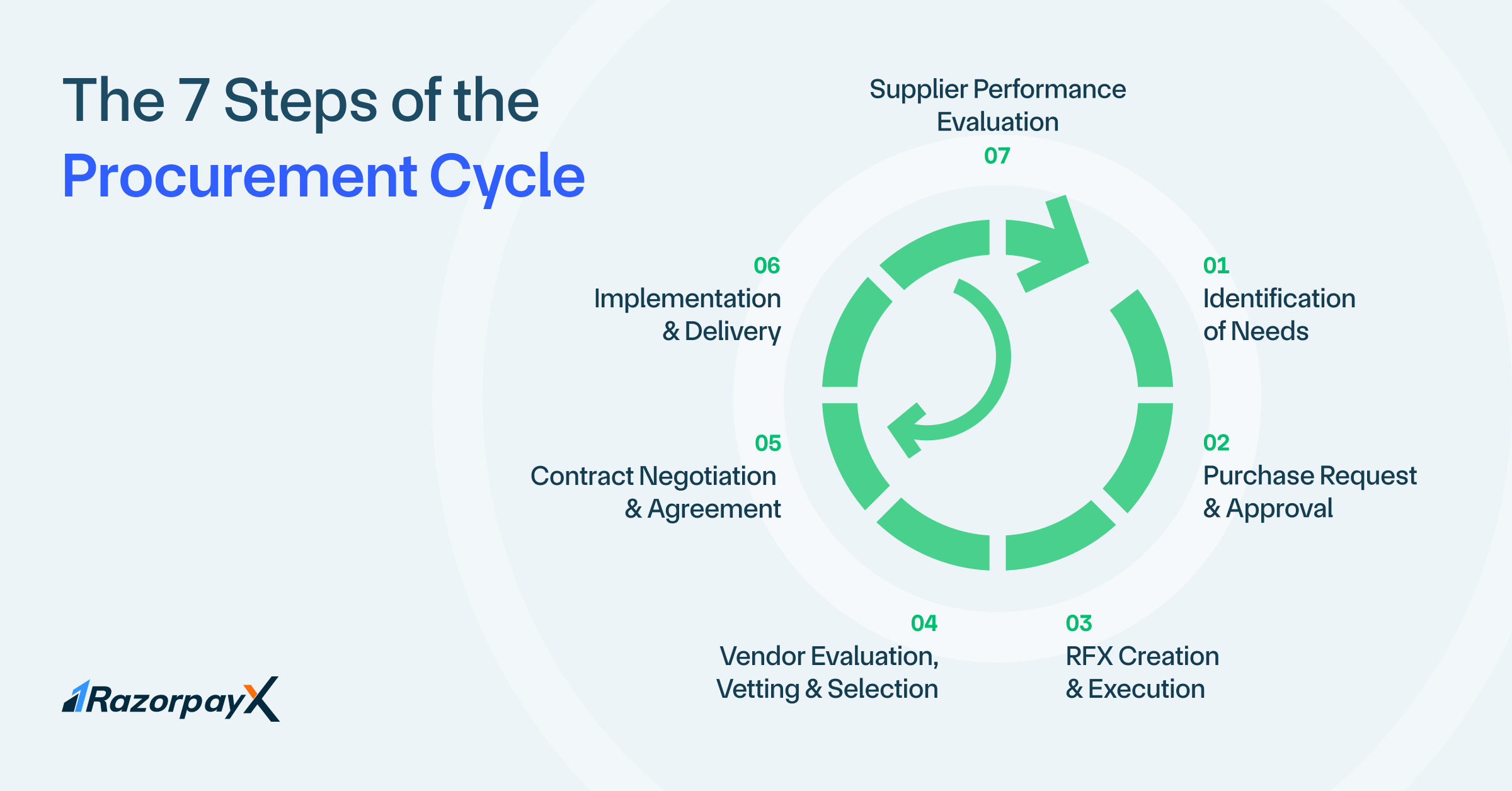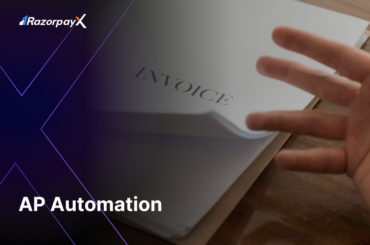Table of Contents
Procurement Cycle Definition
The procurement cycle is the end-to-end process of selecting a vendor, purchasing goods or services, managing invoices and finally making payments. It is also known as the procurement life cycle or procurement process.
All businesses need vendors in some capacity – for raw materials, laptops, desks or even coffee. A good procurement cycle ensures businesses get these goods or services at the best possible price without delays or inconveniences.
Procurement is the umbrella term for all processes related to budgeting, planning, need identification, vendor selection, purchase requisitions and orders, and finally, receiving and paying for the goods or services.
Businesses with automated procurement cycles enjoy significant advantages over businesses with manual processes. Automate and digitize your entire procurement process with RazorpayX’s Source to Pay solution.
Steps in the Procurement Cycle
 Need Identification
Need Identification
The procurement cycle starts when a department or employee requires a particular product or service. For example, the IT department might require antivirus software to combat hacks or viruses in employee laptops, or the marketing department might need branded merchandise like notebooks or pens for an event.
These needs are routed to the procurement department after considering budgets and specifications.
Purchase Requisition & Approval
The requesting department communicates its needs to the procurement department with a Purchase Requisition (PR). The procurement team receives and considers the request against budgets, priorities and other specifications – they may decide to reject or delay the request if they feel it is not within budget or is not a top priority at the moment. They may also recommend existing vendors or solutions to the team.
If the procurement team decides to go ahead and make a new purchase, they then conduct market research and gather a list of potential suppliers, keeping in mind prices, reputation, production capacity, delivery timelines, quality, location, etc.
RFX Creation & Execution
At this stage, the procurement team can also send out an RFX, which is a request for information from the vendor. The “X” is a replaceable variable – which can be:
- RFP: Request for Proposal
- RFI: Request for Information
- RFQ: Request for Quotation
Vendor Evaluation and Selection
At this stage, the procurement team and the requesting department together decide on a vendor from the list. Factors that affect the selection are pricing, vendor reputation, delivery timelines, credit lines, risk assessments, sustainability reports, etc.
All this information is obtained from the various RFXs created and executed by the procurement team.
Contract Negotiation & Onboarding
Once a vendor is selected, the deal is finalized with a legal contract. Both parties’ legal departments meet and discuss the technicalities of the agreement and come to a mutually-agreed conclusion. The agreement should be mutually beneficial and facilitate a long-term, profitable relationship.
The agreement should contain details like:
- Scope of work: Clear definition of services or products to be provided by vendor
- Payment terms: Clear outline of payment schedule, including amounts and due dates
- Service Level Agreements: Defined performance metrics, remedies for non-compliance
- Termination clauses: Conditions under which either party can terminate agreement
- Confidentiality provisions: Protection of sensitive information shared
- Dispute resolution process: A mechanism for resolving disagreements
Once a contract is finalized, the business can then onboard the vendor into their systems. Tools like RazorpayX Source to Pay come with a vendor portal, where vendors can use self-serve dashboards to enter their information and access documents. This makes the entire process transparent and super smooth.
Order and Delivery
This is the stage where the order for the goods and services is placed. The vendor works on delivering the goods or services, and then raises an invoice with the vendor, upon which the business will make the final payment.
Vendor Performance Review
At this stage, the business reviews the quality of goods and services rendered, delivery timelines, and the overall relationship with the vendor. This analysis is usually done at regular intervals when deciding whether to renew the agreement or not.
Post review, the business can decide to renew the contract if all checks turn out positive; they may choose to negotiate the terms of the contract, or even cancel it if the vendor is unsatisfactory.
After this, the cycle restarts – hence the term procurement lifecycle.
Tools Used in the Procurement Cycle
The procurement cycle is highly prone to errors and delays. This is because the process is dependent on multiple stakeholders, complex timelines, documents and paper trails, approvals and more.
With an automated solution, the process of procurement becomes streamlined. When a need arises within a department, an employee can submit a purchase requisition electronically. The system can then automatically route it for approvals based on pre-defined criteria, eliminating the need for physical paperwork and email chains.
Automation extends beyond approvals. Once a vendor is chosen, the software can auto-generate purchase orders with pre-populated data, reducing errors and saving time. It can also automate communication with vendors, send reminders for approvals, and even facilitate electronic invoicing.
This streamlines the entire process, freeing up procurement teams to focus on strategic initiatives and supplier relationship management.
RazorpayX Source to Pay is an industry-first solution to every business’s procurement struggles:
- Advanced custom workflows, allowing for multi-layered approval workflows and rule-based approval automation
- Avoid money loss from vendor GST ITC non-compliance
- Control spends with budgeting and department-wise cost center visibility
- Connect with accounting software for real-time sync and automatic reconciliation
FAQs
What are the different stages of the procurement cycle?
The procurement cycle is a multi-step process that ensures your company acquires the goods and services it needs efficiently. It typically starts with identifying a need, like needing new office supplies. Then, a formal request is submitted for approval by relevant departments. Once approved, the search for qualified vendors begins. This involves soliciting bids, comparing options, and selecting the best supplier based on factors like price, quality, and reliability. The next step involves negotiating the contract terms with the chosen vendor, outlining the specifics of the purchase. Once agreed upon, a purchase order is issued, detailing exactly what is being procured. Upon delivery, the goods or services are inspected to ensure they meet expectations. Finally, the vendor's invoice is reviewed and processed for payment.
What are the benefits of a well-defined procurement cycle?
A well-defined procurement cycle offers a range of advantages for your company. Firstly, it streamlines the process, saving time and resources by eliminating unnecessary steps and delays. Secondly, a well-defined process allows for better negotiation with vendors, potentially leading to cost savings. Furthermore, it helps ensure compliance with internal policies and external regulations. A clear and defined procurement cycle also mitigates risks associated with unreliable suppliers or unclear contracts. Finally, it provides a transparent audit trail for all purchases, making it easier to track spending and identify areas for improvement.
How can automation benefit the procurement cycle?
Procurement software can significantly improve the efficiency of the procurement cycle. By automating many tasks, such as approvals, order processing, and communication with vendors, the software reduces the risk of errors caused by manual data entry. This automation also leads to faster processing times, which can expedite deliveries and improve overall efficiency. Procurement software also provides real-time data and insights, giving you greater visibility into your spending and inventory levels. Additionally, it can facilitate collaboration between internal teams and vendors by streamlining communication channels.
What are some common challenges faced in the procurement cycle?
There are several challenges that can arise during the procurement cycle. One common issue is lengthy approval processes, where manual approvals can significantly slow down the entire process. Another challenge is managing suppliers. Ensuring reliable vendors and effectively monitoring their performance is crucial for successful procurement. Inaccurate or incomplete data can also lead to errors and inefficiencies throughout the cycle. Furthermore, failing to comply with relevant regulations can result in penalties for your company. Finally, limited visibility into spending and budget management can make it difficult to optimize your procurement strategies.





